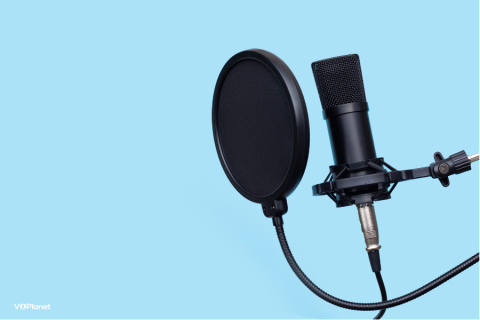
All About Pop Filters For Voice Overs
In the intricate world of audio recording, where clarity and precision are paramount, pop filters emerge as unsung heroes. Whether you’re a seasoned voice actor or embarking on your first recording venture, understanding the significance of pop filters can elevate your performance and ensure your voice cuts through with clarity and richness and that you save time cleaning up your audio. In this guide, we delve into everything you need to know about pop filters: from their function and types to tips on choosing the right one and maximizing its effectiveness.
What Is a Pop Filter?
A pop filter, also known as a pop shield or windscreen, is a device used in audio recording to reduce or eliminate popping sounds caused by the impact of plosive consonants (such as "p" and "t") and strong bursts of air hitting the microphone. Pop filters are typically made from a thin layer of acoustically transparent material—such as nylon mesh, metal mesh, or foam. A pop filter is positioned between the microphone and the speaker's mouth and disperses the airflow, minimizing unwanted noises in voice overs.
Types of Pop Filters
In voice over work, the most commonly used pop filters include nylon mesh, metal mesh, and foam filters. Nylon mesh pop filters are popular for their ability to effectively reduce plosive sounds while maintaining clarity in vocals. Metal mesh pop filters offer durability and robust protection against plosives, making them a reliable choice for professional voice over studios. Foam pop filters are favored for their affordability and ability to soften plosive sounds without compromising audio quality. Each type has its strengths, catering to different preferences and recording environments in voice over production.
Learn more about voice overs: What To Include In a Voice Over Invoice
Benefits of Pop Filters
Pop filters provide several benefits that enhance voice over recordings. By effectively minimizing plosive sounds caused by consonants like "p" and "t," pop filters ensure a smoother and more consistent audio experience. This reduction in plosives results in clearer vocals and prevents distortion, allowing voice actors to deliver their lines with greater clarity and precision. They also help you eliminate the need for rerecording or sound treating voice files with popped Ps. Pop filters also help protect microphones from saliva and moisture, extending their lifespan and maintaining optimal performance over time. Pop filters contribute significantly to achieving professional-grade voice recordings by enhancing audio clarity and ensuring a polished final product in voice over productions.
Do I Need a Pop Filter for Voice Overs?
While not mandatory, using a pop filter for voice overs is highly recommended. Pop filters effectively reduce plosive sounds that can distort recordings, ensuring smoother and more professional audio quality. Pop filters also contribute to maintaining consistency in vocal clarity, especially when recording close-mic vocals common in voice over work. If you’re looking to do professional voice over work, investing in a quality pop filter can significantly enhance the overall quality of your voice overs, making them more polished and appealing to listeners.
Proper Placement of Pop Filters
Ideally, position the pop filter about two to three inches away from the microphone, ensuring it covers the entire area where your voice will project. The filter should be placed directly in front of your mouth, aligned with the microphone, to intercept plosive sounds before they reach the microphone diaphragm. Adjust the angle of the pop filter to direct airflow away from the microphone while maintaining an unobstructed path for your voice.

DIY Pop Filter Option
Pop filters vary in price depending on their type, brand, and quality. Basic pop filters made of nylon mesh or foam are quite affordable, ranging from $10 to $30. These are commonly used and provide effective plosive reduction for most voice over and recording needs.
However, if you’re looking for a quick DIY option, one popular method involves using a fine nylon stocking stretched over a circular frame, such as a wire coat hanger bent into a round shape. Secure the stocking tightly and position it between your mouth and the microphone, ensuring it covers the entire recording area. While DIY pop filters may not offer the same durability or precision as commercial ones, they can serve well in a temporary situation where professional equipment isn't readily available.
Pop Filter Maintenance and Care
Regular maintenance and proper care are essential to the performance and longevity of your pop filter. You should inspect the pop filter for any visible debris or buildup after each use. Nylon pop filters are easy to clean. You can gently hand wash the filter with soapy water to remove accumulated dust and debris. Rinse it well and allow it to air dry completely before reuse.
Pop filters stand as indispensable tools for achieving pristine audio recordings. Whether you're recording in a client’s studio or from the comfort of your home setup, investing in a quality pop filter is a worthwhile step towards enhancing your voice over performances.
You may also enjoy: What Do You Call Someone Who Does Voice Overs?




 VOPlanet Blog
VOPlanet Blog